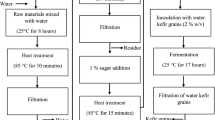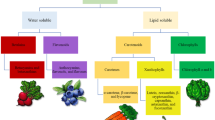Abstract
The study of the stability of anthocyanins in food colorant powder is important to predict the quality changes occurring as the food products are processed, to prevent and control the degradation of the anthocyanins. The objectives of this study were to identify anthocyanin components in natural food colorants obtained from black rice bran, and investigate their thermal stability at 60, 80, and 100 °C, pH stability from 2.0 to 5.0 and also their correlation with visual color, L *, C *, and h°. Results showed that only six types of anthocyanins, cyanidin-3-O-glucoside, cyanidin-3-O-rutinoside, delphinidin, cyanidin, pelargonidin and malvidin were present in raw black rice bran (BRB) and black rice bran colorant powder (BCP). The thermal degradation of both the visual color and the anthocyanin content in the BCP followed a first-order kinetic reaction model. The temperature-dependent degradation was adequately fitted to the Arrhenius equation. In terms of the pH stability, increasing pH values resulted in lower activation energies (E a ) and higher half-life (t 1/2 ) values for both color parameters and individual anthocyanins when heating from 60 to 100 °C. Moreover, the degradation rate constant (k) increased with increasing temperature and pH value. The degradation of cyanidin-3-O-glucoside and total anthocyanins showed a strong positive correlation with C *. The changes in visual color may be used as an on-line quality control indicator during thermal processing of food products containing rice bran colorants which have high anthocyanin content.



Similar content being viewed by others
References
AOAC (2000) Official methods of analysis. Association of official analytical chemist international, 17th edn. AOAC International, Gaithersburg
Castañeda-Ovando A, Lourdes Pacheco-Hernández MDL, Páez-Hernández ME, Rodríguez JA, Galán-Vidal CA (2009) Chemical studies of anthocyanins: a review. Food Chem 113:859–871. doi:10.1016/j.foodchem.2008.09.001
Cevallos-Casals BA, Cisneros-Zevallos L (2004) Stability of anthocyanin-based aqueous extracts of Andean purple corn and redfleshed sweet potato compared to synthetic and natural colorants. Food Chem 86(1):69–77. doi:10.1016/j.foodchem.2003.08.011
Chandra A, Nair MG, Iezzoni AF (1993) Isolation and stabilization of anthocyanins from tart cherries (Prunus cerasus L.). J Agric Food Chem 41(7):1062–1065. doi:10.1021/jf00031a009
Chou PH, Matsui S, Misaki K, Matsuda T (2007) Isolation and identification of xenobiotic aryl hydrocarbon receptor ligands in dyeing wastewater. Environ Sci Technol 41(2):652–657. doi:10.1021/es061500g
Duangmal K, Saicheua B, Sueeprasan S (2008) Color evaluation of freeze-dried Roselle extract as a natural food colorant in a model system of a drink. J LWT Food Sci Technol 41:1437–1445. doi:10.1016/j.lwt.2007.08.014
Durst RW, Wrolstad RE (2001) In current protocols in food analytical chemistry. In: Wrolstad RE (ed), Wiley, New York, pp 1–13.
Escribano-Bailon MT, Santos-Buelga C, Rivas-Gonzalo JC (2004) Anthocyanins in cereals: Review. J Chromatogr A 1054:129–141
Fleschhut J, Kratzer F, Rechkemmer G, Kulling SE (2006) Stability and biotransformation of various dietary anthocyanins in vitro. Eur J Clin Nutr 45(1):7–18. doi:10.1007/s00394-005-0557-8
Frank T, Reichardt B, Shu Q, Engel HK (2012) Metabolite profiling of colored rice (Oryza sativa L.) grains. J Cereal Sci 55:112–119. doi:10.1016/j.jcs.2011.09.009
Hou Z, Qin P, Zhang Y, Cui S, Ren G (2013) Identification of anthocyanins isolated from black rice (Oryza sativa L.) and their degradation kinetics. Food Res Int 50(2):691–697. doi:10.1016/j.foodres.2011.07.037
Hyun JW, Chung HS (2004) Cyanidin and malvidin from Oryza sativa cv. Heungjinjubyeo mediate cytotoxicity against human monocytic leukemia cells by arrest of G(2)/M phase and induction of apoptosis. J Agric Food Chem 52:2213–2217. doi:10.1021/jf030370h
Jang S, Xu Z (2009) Lipophilic and hydrophilic antioxidants and their antioxidant activities in purple rice bran. J Agric Food Chem 57:858–862. doi:10.1021/jf803113c
Jie L, Xiao-ding L, Yun Z, Zheng-dong Z, Zhi-ya Q, Meng L, Shao-hua Z, Shuo L, Meng W, Lu Q (2013) Identification and thermal stability of purple-fleshed sweet potato anthocyanins in aqueous solutions with various pH values and fruit juices. Food Chem 136:1429–1434. doi:10.1016/j.foomchem.2012.09.054
Kara S, Ercelebi AE (2013) Thermal degradation kinetics of anthocyanins and visual colour of Urmu mulberry (Morus nigra L.). J Food Eng 116:541–547. doi:10.1016/j.jfoodeng.2012.12.030
Kennedy JA, Waterhouse AL (2000) Analysis of pigmented high-molecular mass grape phenolics using ion-pair, normal-phase high-performance liquid chromatography. J Chromatogr A 866(1):25–34
Lipman AL (1996) Current regulations for certification exempt color activities in the USA. In Proceeding of the second international symposium on natural colorants INF/COL II. Acapulco, Mexico: The Hereld Oraganization, S.I.C. Publishing.
Loypimai P, Moonggarm A, Chottanom P (2009) Effects of ohmic heating on lipase activity, bioactive compounds and antioxidant activity of rice bran. Aust J Basic Appl Sci 3(4):3642–3652
Loypimai P, Moonggarm A, Chottano P, Moontree T (2015) Ohmic heating-assisted extraction of anthocyanins from black rice bran to prepare a natural food colorant. Innov Food Sci Emerg Technol 27:102–110. doi:10.1016/j.ifset.2014.12.009
Lozano JE, Ibarz A (1997) Colour changes in concentrated fruit pulp during heating at high temperatures. J Food Eng 31:365–373
Mozetic B, Trebse P, Simcic M, Hribar J (2004) Changes of anthocyanins and hydroxycinnamic acids affecting the skin colour during maturation of sweet cherries (Prunus avium L.). LWT Food Sci Technol 37:123–128. doi:10.1016/S0023-6438(03)00143-9
Nam SH, Choi SP, Kang MY, Koh JH, Kozukue N, Friedman M (2006) Antioxidative activities of bran extracts from twenty one pigmented rice cultivars. Food Chem 94:613–620. doi:10.1016/j.foodchem.2004.12.010
Nontasan S, Moongngarm A, Deeseenthum S (2012) Application of functional colorant prepared from black rice bran in yogurt. APCBEE Procedia 2:62–67. doi:10.1016/j.apcbee.2012.06.012
Pereira-Caro G, Watanabe S, Crozier A, Fujimura T, Yokota T (2013) Phytochemical profile of a Japanese black-purple rice. Food Chem 141:2821–2827. doi:10.1016/j.foodchem.2013.05.100
Philpott M, Gould KS, Lim C, Ferguson L (2004) In situ and in vitro antioxidant activity of sweet potato anthocyanins. J Agric Food Chem 52(6):1511–15113. doi:10.1021/jf034593j
Rein M (2005) Copigmentation reactions and color stability of berry anthocyanins. University of Helsinki, Helsinki, pp. 10–14
Ryynänen M, Lampi A, Salo-Väänänen P, Ollilainen V, Piironen VA (2004) A small-scale sample preparation method with HPLC analysis for determination of tocopherols and tocotrienols in cereals. J Food Compos Anal 17:749–765. doi:10.1016/j.jfca.2003.09.014
Shao-qian C, Liang L, Si-yi P (2011) Thermal degradation kinetics of anthocyanins and visual color of blood orange juice. Agric Sci China 10(12):1992–1997. doi:10.1016/S1671-2927(11)60201-0
Torskangerpoll K, Andersen OM (2005) Colour stability of anthocyanins in aqueous solutions at various pH values. Food Chem 89(3):427–440. doi:10.1016/j.foodchem.2004.03.002
Wang WD, Xu SY (2007) Degradation kinetics of anthocyanins in blackberry juice and concentrate. J Food Eng 82(3):271–275. doi:10.1016/j.jfoodeng.2007.01.018
Wrolstad RE (2000) Anthocyaninis. In: Lauro GJ, Francis FJ (eds) Natural food colorants: science and technology. Marcel Dekker, New York
Wu X, Gu L, Prior RL, McKay S (2004) Characterization of anthocyanins and proanthocyanidins in some cultivars of ribes, aronia, and sambucus and their antioxidant capacity. J Agric Food Chem 52(26):7846–7856. doi:10.1021/jf0486850
Yang ZD, Han YB, Gu ZX, Fan GJ, Chen ZG (2008) Thermal degradation kinetics of aqueous anthocyanins and visual color of purple corn (Zea may L.) cob. Innov Food Sci Emerg Technol 9(3):341–347. doi:10.1016/j.ifset.2007.09.001
Yawadio R, Tanimori S, Morita N (2007) Identification of phenolic componds isolated from pigmented rices and their aldose reductase inhibitory activities. Food Chem 101(4):1616–1625. doi:10.1016/j.foodchem.2006.04.016
Zhang X, Shen Y, Prinyawiwatkul W, King JM, Xu Z (2013) Comparison of the activities of hydrophilic anthocyanins and lipophilic tocols in black rice bran against lipid oxidation. Food Chem 141:111–116. doi:10.1016/j.foodchem.2013.03.034
Acknowledgments
The authors gratefully acknowledge the Faculty of Technology, Mahasarakham University and Bansomdejchaopraya Rajabhat University, Thailand, for financial support.
Author information
Authors and Affiliations
Corresponding author
Additional information
Highlights• Natural food colorant powder was prepared from black rice bran.• Thermal and pH stability of the colorant powder were investigated. • Correlations between anthocyanin degradation and visual color were investigated.• Six types of anthocyanins were found in black rice bran and colorant powder.• The degradation of total anthocyanins showed a strong positive correlation with C*.
Rights and permissions
About this article
Cite this article
Loypimai, P., Moongngarm, A. & Chottanom, P. Thermal and pH degradation kinetics of anthocyanins in natural food colorant prepared from black rice bran. J Food Sci Technol 53, 461–470 (2016). https://doi.org/10.1007/s13197-015-2002-1
Revised:
Accepted:
Published:
Issue Date:
DOI: https://doi.org/10.1007/s13197-015-2002-1




